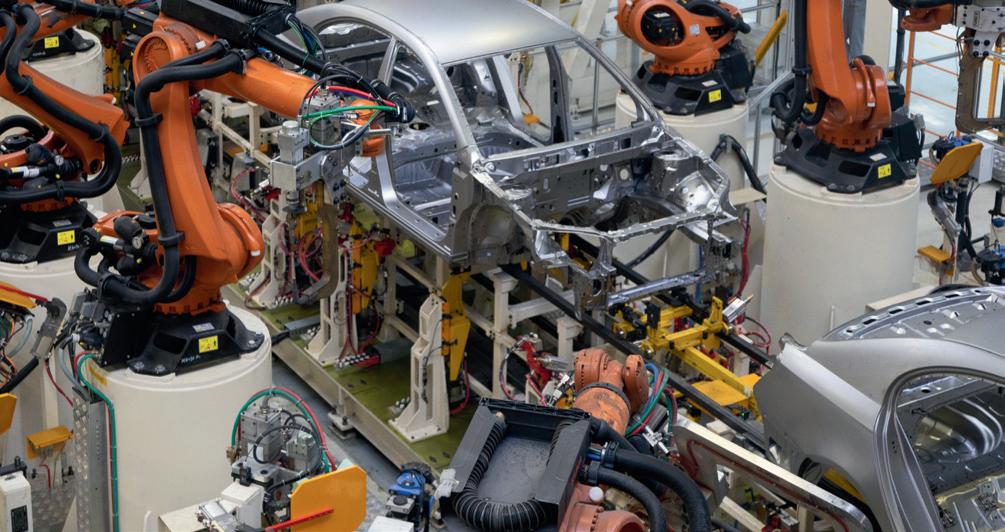
7 minute read
Fighting the common enemy through OT/IT cybersecurity convergence
© Stock.Adobe.com/au/Ivan Traimak
Much discussed in recent years, OT/IT convergence is aimed at creating a synergy that provides businesses with strategic insights that can significantly improve internal processes, business decisions, productivity and competitiveness.
However, with the spread of IT functions and technologies into OT environments — and the subsequently enhanced interconnectivity — some of the cybersecurity risks associated with IT systems can seep into OT networks. Some companies are already experiencing a systemic interdependent cyber risk between the OT and IT sides of the business.
Operational friction between OT and IT
OT and IT personnel come to the table with different agendas, with different operating procedures and roles to play. OT engineers and plant managers are all about keeping the production going, and making sure it is safe, while trying to increase productivity and output. In relation to cybersecurity, system availability is their highest concern.
The IT cybersecurity view is all about protecting the company’s IP, information systems, customer data and business transactional data. In relation to cybersecurity, system confidentiality is their highest concern, over system and data availability or integrity.
As edge computing moves into the industrial environment and industrial process data is connected to external or in-house cloud technologies, the lines of responsibility for cybersecurity become blurred. Even if a company can maintain an effective air-gap between OT and IT environments (through effective firewall and edge gateway strategies for example), production and asset data is now moved into a realm where concerns of confidentiality may become more important. Conversely, traditional IT cybersecurity strategies cannot be realistically employed in OT environments, for technical and business reasons that have been described exhaustively elsewhere — and as is well recognised by every OT engineer.
Achieving a common cybersecurity viewpoint
Ultimately, it is to the benefit of both the OT and IT sides of the business that comprehensive and unified visibility of both OT and IT environments is achieved. This will give OT and IT teams the ability to isolate issues and reduce the friction involved in the activities required to mitigate cyber risk, as well as during incident response.
Even in OT systems that are still air-gapped, many still use IP-based control networks and operators still install software updates provided by the manufacturer, and will not be patched and updated regularly. This leaves open security vulnerabilities that can be exploited, typically by inadvertently introduced malware. Such infiltrations can cause costly disruptions and safety issues.
One way such risks can be mitigated is through the use of next-generation firewalls (NGFW) that can track network activity, accompanied by comprehensive cybersecurity tracking and reporting, as well as AI-powered threat intelligence.
The corporate IT infrastructure also needs a broad, integrated and automated cybersecurity technology that meets the same objectives of risk mitigation and reduced time to detection and response.
In the past, the IT side of the business has been well served by tools and techniques to achieve such goals. Similarly, over recent years the operational side of the business is also presented with many techniques and tools to achieve its cybersecurity goals, through industry standards and the support of those standards by large automation industry players.
However, as good as both the OT and IT solutions to the common cybersecurity threat are, this still leaves an OT/IT divide, with differing or disparate solutions to the problem.
A solution in common to a common problem
What is needed today, to reduce or eliminate operational OT/IT cybersecurity friction, is a way to give a comprehensive and common view of assets from a cybersecurity standpoint and a common infrastructure to respond to cyber threats. Such a common security fabric, utilising common NGFWs as well as integrated supporting software tools and threat intelligence, makes it possible to achieve broad visibility into who is on the network and what they are doing, and whether systems and devices are behaving within their normal operating parameters.
The alignment of cybersecurity risk mitigation and response strategies is key to minimising the risk associated with the alignment of business and operational goals through OT/IT integration. Only in this way can the friction between the aims of OT and IT teams be reduced, and the mean time to detection and response in the case of a cybersecurity incident be minimised.
Michael Murphy is the head of operational technology and critical infrastructure for Fortinet in Australia. His focus is on helping organisations build cyber resilience for OT and understanding how to achieve strong outcomes for OT security. Michael has held roles as a cybersecurity practitioner and senior sales engineer and has built OT incident response teams in Australia, New Zealand, London, Hong Kong and Singapore.
AVEVA PLANT SCADA 2020 R2 TAPS INTO THE FULL POTENTIAL OF THE AVEVA PORTFOLIO
As global industry accelerates plans for digital transformation and seeks reliable and flexible SCADA solutions, many companies are shifting to tightly integrated stacks of solutions to solve increasingly interconnected operational challenges.
As HMI/SCADA software continues to evolve, AVEVA Plant SCADA has grown as well. Users will find it easier than ever to explore solutions that deliver collaboration, skills management, deep analytics, and artificial intelligence. Industrial operations must reimagine traditional HMI/SCADA to support the future potential of operations control.

AVEVA Plant SCADA unlocks the full potential of integrated operations control
AVEVA is already exploring ways to bring the familiarity of traditional HMI/SCADA software to a more integrated style of operations, centred around common information platforms and unified operations. AVEVA Plant SCADA represents an example of the way legacy SCADA software can be updated to play a powerful role in unified operations while maintaining features that customers have come to rely on over decades.
AVEVA Plant SCADA began its development lifecycle as a part of Citect, and quickly gained dominance of the SCADA market in the Asia Pacific region. When Citect became part of Schneider Electric and then AVEVA, Citect SCADA was integrated with the AVEVA portfolio.
Now, the same team who created Citect SCADA provides AVEVA Plant SCADA. They’ve kept the features customers have come to rely on like legacy image libraries and graphics editors, but they’ve infused Plant SCADA with common tools shared across AVEVA’s rich portfolio, like industrial graphics and a powerful read/write web client based on HTML5.
Comprehensive operations with AVEVA
AVEVA hasn’t just made this trusted SCADA software better, it has made it a full part of AVEVA operations capabilities. Operations control is a framework of information and teams that allow organisations to break down operational silos and show one unified vision of operations that managers and operators can use to make better decisions and improve processes.
Plant SCADA serves an important role within operations control, and organisations using Plant SCADA can already take advantage of other powerful AVEVA solutions designed to unify systems and teams. For example, Plant SCADA supports
© Stock.Adobe.com/au/Sikov
industrial graphics, which allows users to import and export rich graphics libraries to other systems.
AVEVA Connect is another important piece of the AVEVA operations control portfolio. Within AVEVA connect, Plant SCADA users can centralise their data with AVEVA Data Hub or use AVEVA Insight to understand their asset health and performance.
AVEVA Plant SCADA is also a part of AVEVA Flex, a subscription credits system that allows AVEVA’s customers to use the entire AVEVA operations portfolio with much lower upfront costs. Want to use FLEX to augment Plant SCADA with the edge management solutions of AVEVA Edge? Now you can! Want to bring Plant SCADA data directly into a unified operations centre? AVEVA Flex makes it possible and cost-effective to start experimenting with more complex system architectures and take advantage of powerful automation tools.

AVEVA Select Distributors offer a personal touch
As an AVEVA Select Distributor, Schneider Electric offers the full AVEVA portfolio. This allows it to provide a personal touchpoint for companies executing their digital transformation plans as they explore new ways to structure their teams and break down information silos for a more unified experience of operations.
Schneider Electric’s partnership with AVEVA provides a rich set of solutions that help organisations optimise operations and asset performance, and more easily adopt technologies like artificial intelligence, industrial IoT, big data, cloud, and hybrid-cloud capabilities.
Upgrading to AVEVA Plant SCADA
AVEVA and Schneider Electric always recommend the use of the most recent versions of software to mitigate security risks and implement the latest features and capabilities. If the organisation is currently using a legacy edition of Citect SCADA, updating to AVEVA Plant SCADA will provide the future-ready technology needed to stay competitive.
Never used AVEVA Plant SCADA? Contact our team to request a demo so we can demonstrate how to reduce your operating costs and improve productivity and product quality.

